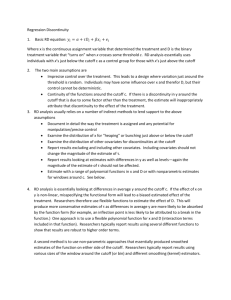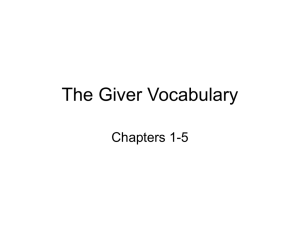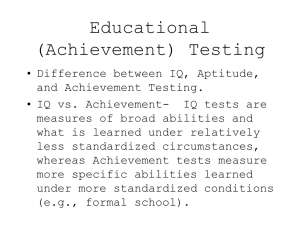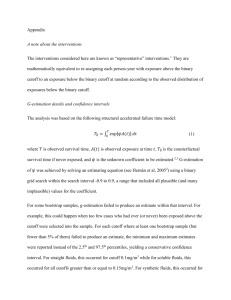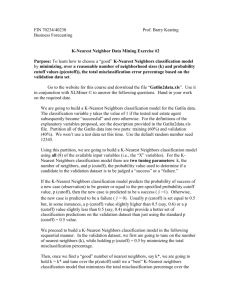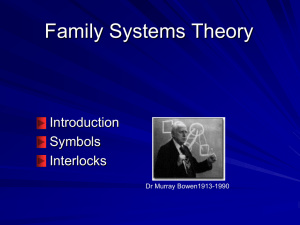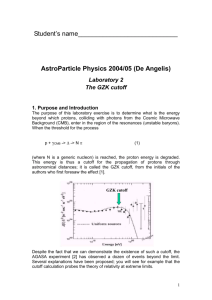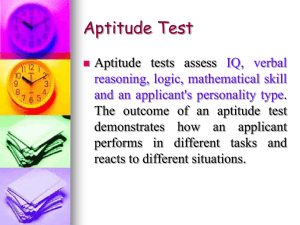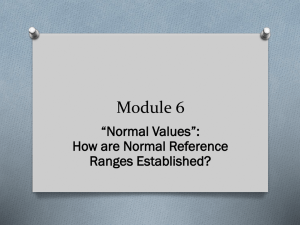Chap. 7 Machine Learning: Discriminant Analysis Part 1
advertisement
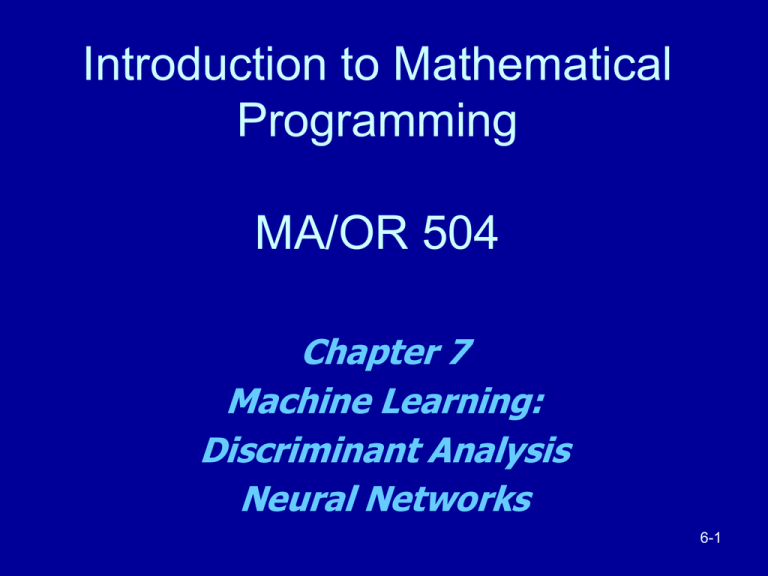
Introduction to Mathematical Programming MA/OR 504 Chapter 7 Machine Learning: Discriminant Analysis Neural Networks 6-1 Chapter 7 Part 1: Discriminant Analysis and Mahalanobis Distance Introduction to Discriminant Analysis (DA) DA is a statistical technique that uses information from a set of independent variables to predict the value of a discrete or categorical dependent variable. The goal is to develop a rule for predicting to which of two or more predefined groups a new observation belongs based on the values of the independent variables. Examples: – Credit Scoring Will a new loan applicant: (1) default, or (2) repay? – Insurance Rating Will a new client be a: (1) high, (2) medium or (3) low risk? Types of DA Problems 2 Group Problems... …regression can be used k-Group Problem (where k>=2)... …regression cannot be used if k>2 Example of a 2-Group DA Problem: ACME Manufacturing All employees of ACME manufacturing are given a preemployment test measuring mechanical and verbal aptitude. Each current employee has also been classified into one of two groups: satisfactory or unsatisfactory. We want to determine if the two groups of employees differ with respect to their test scores. If so, we want to develop a rule for predicting whether new applicants will be satisfactory or unsatisfactory. The Data See file Fig7-1.xls Graph of Data for Current Employees 45 Verbal Aptitude Group 1 centroid 40 Group 2 centroid C1 35 C2 30 Satisfactory Employees Unsatisfactory Employees 25 25 30 35 40 Mechanical Aptitude 45 50 Calculating Discriminant Scores Y i b o b1 X 1 b 2 X 2 i i where X1 = mechanical aptitude test score X2 = verbal aptitude test score For our example, using regression we obtain, ˆ 5 . 373 0 . 0791X 0 . 0272 X Y i 1i 2i Figure 7-2 A Classification Rule If an observation’s discriminant score is less than or equal to some cutoff value, then assign it to group 1; otherwise assign it to group 2 What should the cutoff value be? Possible Distributions of Discriminant Scores Group 1 Y1 Group 2 Cut-off Value Y2 Cutoff Value For data that is multivariate-normal with equal covariances, the optimal cutoff value is: Y1 Y2 Cutoff Value = 2 For our example, the cutoff value is: Cutoff V alue = 1.193 1.764 1.479 2 Even when the data is not multivariate-normal, this cutoff value tends to give good results. Calculating Predicted Group See file Fig7-3.xls A Refined Cutoff Value Costs of misclassification may differ. Probability of group memberships may differ. The following refined cutoff value accounts for these considerations: Cutoff Value = Y1 Y2 2 2 p C (12 | ) LN 2 p C ( 2 | 1 ) 1 Y1 Y2 Sp Classification Accuracy Actual Group 1 2 Total Predicted Group 1 2 9 2 2 7 11 9 Total 11 9 20 Accuracy rate = 16/20 = 80% Classifying New Employees See file Fig7-4.xls The k-Group DA Problem Suppose we have 3 groups (A=1, B=2 & C=3) and one independent variable. We could then fit the following regression function: Y i b 0 b1 X 1 i The classification rule is then: If the discriminant score is: Assign observation to group: 1.5 Y A i 1.5 Y 2 .5 B i 2 .5 Y i C Graph Showing Linear Relationship Y 3 2 Group A 1 Group B Group C 0 0 1 2 3 4 5 6 7 X 8 9 10 11 12 13 The k-Group DA Problem Now suppose we re-assign the groups numbers as follows: A=2, B=1 & C=3. The relation between X & Y is no longer linear. There is no general way to ensure group numbers are assigned in a way that will always produce a linear relationship. Graph Showing Nonlinear Relationship Y 3 2 1 Group A Group B Group C 0 0 1 2 3 4 5 6 7 X 8 9 10 11 12 13 Example of a 3-Group DA Problem: ACME Manufacturing All employees of ACME manufacturing are given a pre-employment test measuring mechanical and verbal aptitude. Each current employee has also been classified into one of three groups: superior, average, or inferior. We want to determine if the three groups of employees differ with respect to their test scores. If so, we want to develop a rule for predicting whether new applicants will be superior, average, or inferior. The Data See file Fig7-5.xls Graph of Data for Current Employees 45.0 Group 1 centroid Verbal Aptitude 40.0 Group 3 centroid C1 C2 35.0 C3 30.0 Group 2 centroid 25.0 25.0 30.0 35.0 40.0 Mechanical Aptitude Superior Employees Average Employees Inferior Employees 45.0 50.0 The Classification Rule Compute the distance from the point in question to the centroid of each group. Assign it to the closest group. Distance Measures Euclidean Distance D istance 2 (A 1 A 2 ) ( B1 B 2 ) 2 This does not account for possible differences in variances. 99% Contours of Two Groups X2 P1 C2 C1 X1 Distance Measures Variance-Adjusted Distance D ij k ( xik x jk ) s 2 2 jk where xik is value of obs. i on k th indep. variable x jk is t hemean valueof group j on k th indep. variable 2 th s jk is t hesample varianceof group j on k indep. variable This can be adjusted further to account for differences in covariances. The DA.xla add-in uses the Mahalanobis distance measure. Mahalanobis Distance D (x m) C 2 T 1 (x m) w here: D M ahalanobis distance 2 x vector of data m vector of m ean values of independent variables C 1 inverse of covariance m atrix of independ ent variables 27 Using the DA.XLA Add-In See file Fig7-6.xls For detail, see See file Fig. 7-7 Multivariate Normal Distribution Covariance Matrix x~N px d μ,Σ 1 2 d /2 Σ 1 /2 T 1 1 exp x μ Σ x μ 2 29 Bivariate Normal If X and Y are independent then Cov(X, Y)=0. However, if Cov(X, Y)=0 then X and Y may not be independent. 30 31 Example S uppose X, Y bivariate norm al 500 6292 C 500 3754 3754 1 .00025 C 6280 .00015 .00015 .00025 For (X , Y ) (410, 400), D 1.825 2 32 MBA Admissions Salterdine Univ wants to use DA to determine which applicants to admit to the MBA program. Director believes undergraduate GPA and GMAT score provide useful information for predicting which applicants will be good students. Faculty classify 30 current students in the MBA program into 2 groups: 1) good students, 2) weak students. Information for 5 new applicants has been received by the director. See Fig. 7-8 33 Bank Loans Commercial loan dept. mgr. evaluates loan applications. Important company characteristics for evaluating loan application: 1. Liquidity (ratio of current assets to current liabilities) 2. Profitability (ratio of net profit to sales) 3. Activity (ratio of sales to fixed assets) 18 past loans bank has made are categorized 1. Acceptable 2. One or two late payments 3. Unacceptable, 3 or more late payments Must evaluate 5 new loan applications Fig. 7-9 34 End of Chapter 7

